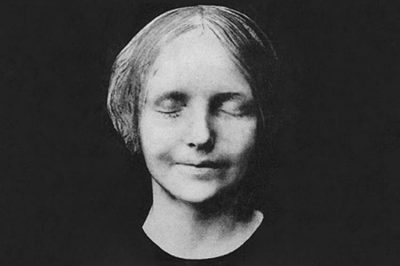Man in Iron Mask: The Identity of a French Prisoner Who Kept his Face Covered with Iron-Mask
Share

Portrait of the Man in Iron Mask. (Library of Congress)
Circa 1669-1670, a man is arrested and incarcerated in a chain of French Prisons with his face covered. He dies in prison in 1703 as someone named ‘Marchioly’. His jail term passed in the custody of one and the same jailor, Saint Mars. For the life of him, he was directed not to reveal his identity to anyone. Who was this unusual prisoner with the iron mask? There are several theories.
Voltaire, the French Writer said (1771) that this prisoner was the elder brother of the reigning King Louis XIV. His surmise was based on his one-to-one with co-prisoners (Voltaire was imprisoned at Bastille for airing views against the government). He said that the chin of the metallic mask was made of steel springs which enabled chewing of food at mealtimes. Quoting oldest prisoners, Voltaire asserted that the condemned man was elite and treated like royalty. It’s hard to rule out though that this could be an imagery of the Writer Philosopher.
The relation between the jailor and the unidentified prisoner
After the death of Saint Mars, it transpired that the jailor was rude to the prisoner he gave company to for more than 3 decades. Money paid by the state for spending on prisoner’s welfare was pocketed by him for his personal use. This was evident from the fact that a prison cell had only one sleeping mat, no other facility.
Records of 1669 show a missive from Marquis de Louvois, a minister of King Louis XIV, to Saint Mars, the governor of the prisons of Pignerol (part of France then). It said that a prisoner named ‘Eustache Dauger’ would arrive in a month’s time and he must be provided top-end security. His cell must be made soundproof with multiple doors. Saint Mars should personally visit the prisoner once daily to inquire about his welfare. Prisoner’s basic needs, it said, would be minimal (since) he came from service class. Governor must also warn prisoner that if he dared reveal his identity, he would be shot dead.
Named ‘Eustache Dauger’ in above letter appeared to be an ‘afterthought’ as it was penned in a different handwriting. Looks like Louis, first of all, dictated the letter to someone and then ‘planted’ a different name in the finished text. Dauger was arrested in Calais bypassing the protocol of informing the local governor about his arrest.
The prison at Pignerol housed a minimum of selected criminals perceived as an irritant to state administration. Eustache Dauger was the most docile of all prisoners. This counters royal blood theory as one from a royal family must have the attitude. In 1681 Saint Mars was transferred to the prison of Exile Fort (presently in Italy). Dauger too moved with him to the same place. In May 1687 the jailor-prisoner duo moved to Sainte Marguerite, an island half a mile offshore from Cannes. It was this transfer which fuelled speculations about a strange prisoner-in-iron-mask. On 18th September 1698, Saint Mars again shifted, to Bastille prison in Paris. There too, Dauger accompanied him. A jail officer observed that the mask was black velvet, not iron.
After the death of the man in iron mask
Dauger, however, died on 19th Nov 1703 and was buried at Fort Royal, Lerin’s Islands, with a different name, Marchioly. All his possessions were carefully destroyed. Even the walls of his cell were scratched clean and repainted. A belated concern of princess Palatine, sister-in-law of King Louis, raked the already muddied waters. She said that two gunmen were constantly watching the prisoner, ready to kill him if he unmasked to reveal his identity. She described Dauger as a deeply religious individual who got VIP treatment in his lock-up. However there is no explanation for why she was silent when Dauger was alive and spoke only 8 years after his death, she wasn’t taken seriously.
According to a University Professor Mr Sonnino, the man-in-iron-mask was assistant to a treasurer in the service of Cardinal Mazarin the Chief Minister of France. In his book: The Search for the Man in the Iron Mask- a Historical Detective Story, he says that Mazarin amassed great wealth by cheating on the previous king and queen of England. Dauger, on a lighter note, spoke about Treasurer’s dishonesty. That infuriated Treasurer to arrest him and put behind the bars. Dauger was also warned that for the life of him he should remain forever incognito.
Why have the historians missed the link of the scheming treasurer?
Mr Sonnino replied that Historians look for a straightforward narrative whereas the truth is too complicated to fit into a simplistic dispensation. He dismissed the popular notion that prisoner always wore a face mask. He said the mask was put on occasionally (most likely during jail to jail transfers) and it was made of velvet (not iron). From 18th century onwards, the identity of the prisoner became a cocktail of facts and fiction. Stories were spun around him and the mystique of veiled face grew unchecked. Latest to harp on this mystique is Leonardo di Capri film ‘the Man in the Iron Mask’ released in 1998.
Hugh Ross Williamson has argued that the prisoner in question was the father of King Louis XIV. Old and physically weak Louis XIII was estranged from his wife Anne for 14 years, and it is likely that his wife conceived (the future King Louis XIV) from an arranged person. The proxy father of Louis XIV migrated to America but returned to France in 1660 and tried to blackmail the royal family over the illegitimacy of the reigning King. That triggered state action for his immediate arrest and incarceration under a fictitious name to keep the King’s honour intact. Various other theories have identified the prisoner as an English Nobleman, son of Louis XIV, a French General, a Government minister and an Italian diplomat.
The last word though is Dauger, his full name – Eustache Dauger de Cavoye. A maverick, Dauger was involved in illegitimate trading of Aphrodisiacs and Poisonous substances. Eventually, he got entangled in the affairs of the poisons, a huge scandal involving the sale of poisons, devil worship and infant sacrifice. Mistress of King Louis was also involved in the scandal. This forced the king to exercise utmost secrecy in prosecution proceedings of the case. The secrecy was also extended to the jail term of the convict producing the myth of the masked prisoner.
Enjoyed this article? Also, check out “Unknown Woman of the Seine or L’Inconnue de la Seine: Timeless Model of the CPR Doll“.
Recommended Read:
The Search for the Man in the Iron Mask: A Historical Detective Story | By Paul Sonnino
Fact Analysis:
STSTW Media strives to deliver accurate information through careful research. However, things can go wrong. If you find the above article inaccurate or biased, please let us know at [email protected]













